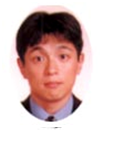|
所属 |
大学院国際資源学研究科 資源開発環境学専攻 |
出身大学 【 表示 / 非表示 】
-
-1999年
九州大学 工学研究科 資源工学 卒業
-
-1999年
九州大学 Graduate School of Engineering 卒業
-
-1994年03月
九州大学 工学部 資源工学科 卒業
-
-1994年
九州大学 工学部 資源工学 卒業
-
-1994年
九州大学 Faculty of Engineering Department of Mining Engineering 卒業
職務経歴(学内) 【 表示 / 非表示 】
-
2016年04月-継続中
秋田大学 大学院国際資源学研究科 資源開発環境学専攻 教授
-
2014年04月-2016年03月
秋田大学 国際資源学部 国際資源学科 資源開発環境コース 教授
-
2009年04月-2014年03月
秋田大学 大学院工学資源学研究科 工学資源学部 教授
-
2007年04月-2009年03月
秋田大学 大学院工学資源学研究科 工学資源学部 准教授
-
2003年02月-2007年03月
秋田大学 工学資源学部 助教授
研究分野 【 表示 / 非表示 】
-
環境・農学 / 環境材料、リサイクル技術
-
環境・農学 / 環境材料、リサイクル技術
-
環境・農学 / 環境負荷低減技術、保全修復技術
-
ナノテク・材料 / 金属生産、資源生産
-
エネルギー / 地球資源工学、エネルギー学
研究等業績 【 表示 / 非表示 】
-
Godirilwe L.L.
Journal of Environmental Chemical Engineering ( Journal of Environmental Chemical Engineering ) 12 ( 5 ) 113884 - 113884 2024年10月
研究論文(学術雑誌)
-
Zhao J.
Minerals Engineering ( Minerals Engineering ) 204 108422 - 108422 2023年12月
研究論文(学術雑誌)
-
Gold Recovery from its Flotation Concentrate using Acidic Thiourea Leaching and Organosilicon Polymer
Altansukh, B., Burmaa, G., Nyamdelger, S., Ariunbolor, N., Shibayama, A., and Haga, K.
International Journal on the Society of Materials Engineering for Resources 20 ( 1 ) 29 - 34 2015年01月
研究論文(学術雑誌) 国内共著
-
Floatability and Bubble Behavior in Seawater Flotation for the Recovering Copper Mineral
Haga, K., Nishioka, K., Altansukh, B., and Shibayama, A.
International Journal on the Society of Materials Engineering for Resources 20 ( 1 ) 82 - 86 2015年01月
研究論文(学術雑誌) 国内共著
-
A Study of Enrichment Process of Rare Earth Elements from Tamagawa Hot Spring Water
Haga, K., Bessho, M., Muniyappan, R. G., and Shibayama, A
International Journal on the Society of Materials Engineering for Resources 20 ( 1 ) 196 - 202 2015年01月
研究論文(学術雑誌) 国内共著
-
Removal of Arsenic and Dissolution of Copper from Arsenic Bearing Copper Ore by High Pressure Oxidative Leaching
A. Shibayama, B. Altansukh, R. Oinuma, K. Haga
Proceedings IMPC2016 2016年01月 [査読有り]
研究論文(国際会議プロシーディングス) 国内共著
-
High Pressuer Oxidative Leachinng of High Arsenic Bearing Copper Ore Under Various Conditions
A. Shibayama, B. Altansukh, R. Oinuma, K. Haga
Proceedings of Copper 2016 2016年01月 [査読有り]
研究論文(国際会議プロシーディングス) 国内共著
-
Sagzhanov D.
Journal of Sustainable Metallurgy ( Journal of Sustainable Metallurgy ) 11 ( 2 ) 754 - 772 2025年06月
-
GODIRILWE Labone L., HAGA Kazutoshi, OINUMA Ryuji, BATNASAN Altansukh, SHIBAYAMA Atsushi
環境資源工学 ( 一般社団法人 環境資源工学会 ) 71 ( 3 ) 138 - 144 2025年
<p>High arsenic (As) content in copper ores and concentrates poses challenges to the smelting/converting process, particularly the environmental implications of arsenic emissions. As an alternative, high-pressure oxidative leaching (HPOL) of enargite ore was investigated in this study to achieve selective dissolution of copper and separation of arsenic from high arsenic-containing copper ore. The effects of leaching conditions such as the type of leaching medium, leaching temperature, and total pressure, were investigated. Ferric sulfate (Fe<sub>2</sub>(SO<sub>4</sub>)<sub>3</sub>) was used as the leaching medium under optimized leaching conditions (160°C and 1.0 MPa total pressure). The results showed that the dissolution of copper from enargite ore was limited to around 65%, due to the agglomeration and passivation of mineral particles caused by elemental sulfur, as shown by SEM-EDS. However, the addition of NaCl as an additive significantly improved the copper dissolution rate to about 82%, while about 98% of arsenic was removed as scorodite (FeAsO<sub>4</sub>•2H<sub>2</sub>O).</p>
-
Sagzhanov D.
Minerals, Metals and Materials Series ( Minerals, Metals and Materials Series ) 201 - 213 2024年
LithiumLithium is one of the critical elements required for clean energy technology to achieve a carbon-neutral target. In this study, the beneficiation ofLow-grade spodumene ore a low-grade spodumene ore (0.3–0.6% Li2O) from Eastern Kazakhstan is investigated by dense medium separation (DMS)Dense Medium Separation (DMS) and froth flotationFlotation to obtain lithiumLithium concentrate. The main gangue minerals in the spodumene ore are feldspar, quartz and mica. The highest lithiumLithiumgrade in concentrate from DMSDense Medium Separation (DMS) of 1000/+ 850 µm size fractions of the low-grade spodumene oreLow-grade spodumene ore is achieved at approximately 5.7% from 0.6% (Li2O), with a recoveryRecovery of about 90%. Furthermore, the spodumene ore is beneficiated by reverse flotationFlotation using NaOL and DAA as mixed collectorsMixed collector. The maximum lithiumLithiumrecoveryRecovery of approximately 30% with the highest lithiumLithium grade of 1.0% was obtained from a low-grade spodumene oreLow-grade spodumene ore under flotationFlotation condition of 1000 g/t NaOL/DAA, ratio of 1:5, pH 10. Conditioning the pulp with starch has little effect on the flotationFlotationrecoveryRecovery of lithiumLithiumfrom low-grade spodumene oreLow-grade spodumene ore improving lithiumLithium grade from 1.0 to 1.45%.
-
Godirilwe L.L.
Sustainability (Switzerland) ( Sustainability (Switzerland) ) 15 ( 13 ) 2023年07月
-
Tin Recovery from WPCBs by Immersion Using Lead-Tin Molten Metal
Ueda S.
World of Metallurgy - ERZMETALL ( World of Metallurgy - ERZMETALL ) 76 ( 4 ) 261 - 266 2023年07月
Waste printed circuit boards (WPCBs) contain a variety of metals, including copper, tin, and precious metals, some of which are valuable. These raw materials are called "urban mines (E-scrap)" and have attracted much attention. Among these, this study focused on solder used on circuit boards. The main component of solder is tin, with trace amounts of silver and copper. Tin has a relatively low melting point among metals and is easy to process. Currently in Japan, WPCBs are mainly recycled via copper smelting with concentrate. However, tin is preferentially oxidized in copper smelting and is mostly dispersed in slag. Currently, the recycling rate of tin in Japan is extremely low at about 8 % [1]. Furthermore, the establishment of a high recovery rate technology for tin is still inadequate. The objective of this study is to improve the tin recycling rate by recovering tin at an earlier stage before feeding the WPCBs into a copper smelting furnace. Therefore, this study focused on the immersion method in lead-tin molten solution as a method to selectively recover solder from WPCBs using the dry smelting method. In the experimental method, WPCBs were immersed in a molten lead-tin alloy solution for a certain amount of time. Subsequently, evaluations were conducted on the substrate side and the alloy side. Optimal conditions for the immersion method were studied and basic tests were conducted to achieve a solder recovery rate of more than 70 % from the WPCBs. The results confirmed that the solder recovery rate by the immersion method was more than 80 % within one minute. This suggests that the immersion method can achieve a high recovery rate in a short time by using a highly conductive alloy. In the future, the continuous immersion testing of substrates and efficient testing conditions will continue to be studied to work toward actual operation.
◆原著論文【 表示 / 非表示 】
◆国際会議プロシーディングス【 表示 / 非表示 】
◆その他【 表示 / 非表示 】
科研費(文科省・学振)獲得実績 【 表示 / 非表示 】
-
迅速的なパラジウムの高効率捕捉を志向した進化型ピンサー抽出剤の創製
基盤研究(B)
研究期間: 2022年04月 - 2026年03月 代表者: 山田 学, 柴山 敦, 芳賀 一寿, 篠田 弘造, 和嶋 隆昌
-
貴金属リサイクルと鉱物処理技術を革新する可変式カニばさみ型マルチコレクターの開発
基盤研究(B)
研究期間: 2019年04月 - 2022年03月 代表者: 柴山敦
-
アミド基含有環状抽出剤の新規合成による白金族リサイクル技術の革新的開発
特別研究員奨励費
研究期間: 2016年11月 - 2019年03月 代表者: 柴山 敦, MUNIYAPPAN RAJIV GANDHI
-
ハロゲン浴浸出とカニばさみ型抽出剤を利用した貴金属リサイクル技術の開発
基盤研究(B)
研究期間: 2016年04月 - 2019年03月 代表者: 柴山敦
-
ハロゲン浴浸出とカニばさみ型抽出剤を利用した貴金属リサイクル技術の開発
基盤研究(B)
研究期間: 2016年04月 - 2019年03月 代表者: 柴山 敦, 山田 学, 芳賀 一寿, バトナサン アルタンスック, 岡部 悠
学内活動 【 表示 / 非表示 】
-
2021年04月-継続中国際資源学教育研究センター長 (センター・施設長)
-
2017年04月-2019年03月国際資源学部入試委員長 (全学委員会)
-
2015年04月-2018年03月評議員 (全学委員会)
-
2012年04月-2015年03月特別貢献教授 (その他の主要活動)
-
2011年04月-2016年03月ベンチャー・ビジネス・ラボラトリー長 (センター・施設長)
学会・委員会等活動 【 表示 / 非表示 】
-
資源・素材学会
2020年-2021年理事
-
環境資源工学会
2019年-継続中理事
-
日本素材物性学会
2015年-継続中会長
-
日本学術会議
2011年10月連携会員
-
廃棄物学会
2003年東北支部 幹事

